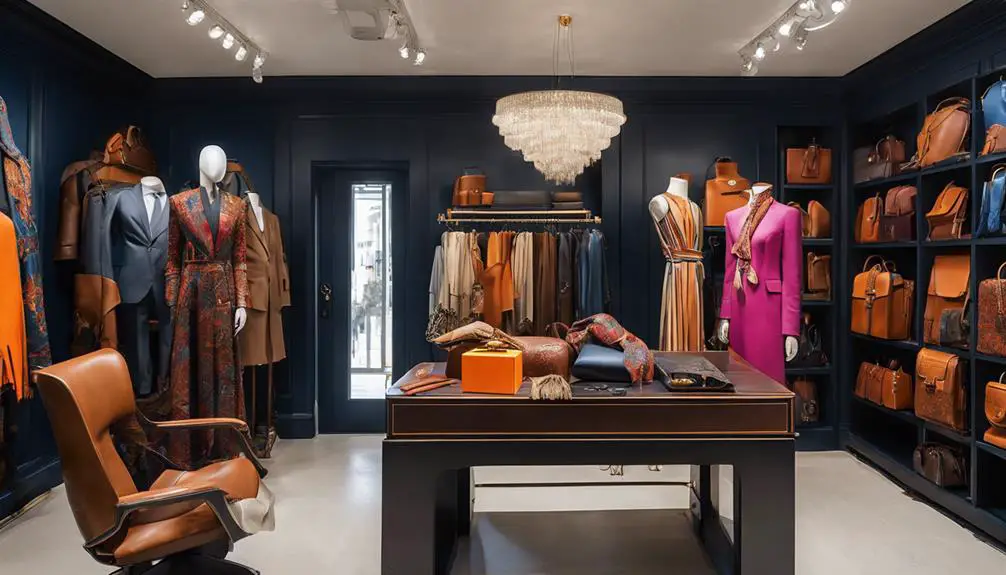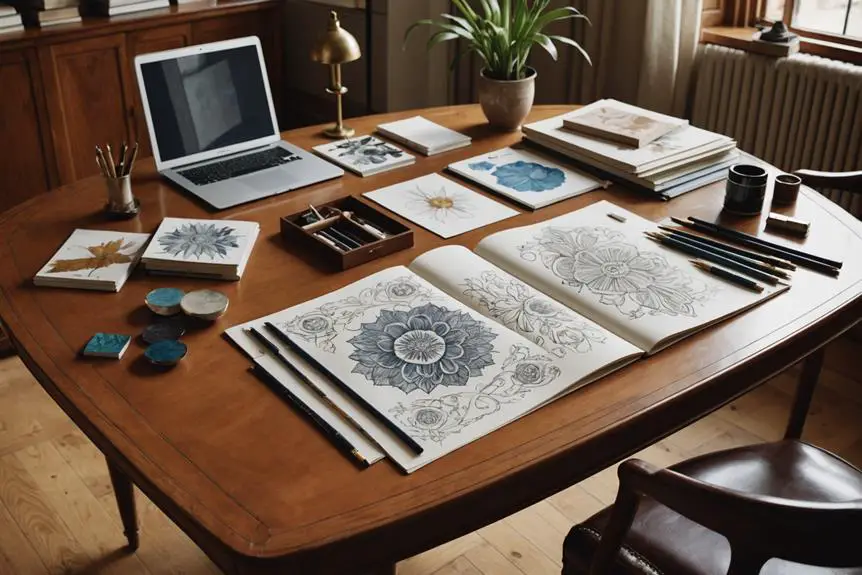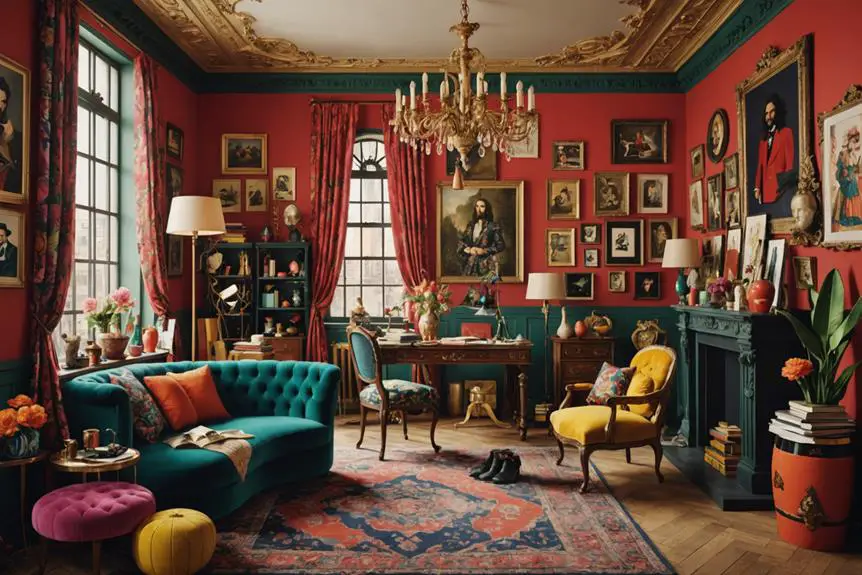You might find it interesting that the same day you stumbled upon a vintage Hermès scarf, a discussion about the brand's iconic designers surfaced at a nearby café. These designers haven't just created products; they've woven their narratives into the fabric of luxury fashion. From the legendary bags to unique textiles, each piece reflects a commitment to craftsmanship and artistry. What's remarkable is how these creative minds have balanced innovation with tradition, yet the question remains: how do their distinct visions continue to shape Hermès today?
Historical Foundations of Hermès

Exploring the historical foundations of Hermès reveals a legacy rooted in exceptional craftsmanship and luxury. Founded in 1837 by Thierry Hermès, the brand initially specialized in high-quality harnesses and saddles for European nobility. This focus on craftsmanship quickly garnered attention, with Hermès winning awards at the Expositions Universelles in 1855 and 1867, showcasing its technical achievements in harness making.
In 1880, the company moved to 24 Rue du Faubourg Saint-Honoré, a significant step that elevated its reputation for excellence and luxury. Under the guidance of Émile Hermès in 1922, the company diversified into leather goods, introducing luxurious handbags that have since become iconic symbols of style and sophistication. Hermès' commitment to artisanal craftsmanship remains unwavering, blending traditional techniques with contemporary designs to create luxury products that resonate with discerning customers.
As you investigate deeper into the world of Hermès, you'll discover that the brand's historical foundations are not just about the past; they're about a continuous pursuit of perfection. Each piece reflects the dedication of six generations of artisans who have upheld the brand's legacy. From the meticulous selection of materials to the skilled hands that craft these stunning leather goods, Hermès embodies an artistry that transcends time, making it a leader in the luxury market. With every iconic handbag, you're not just purchasing a product; you're investing in a piece of history, craftsmanship, and unparalleled luxury.
Iconic Designers and Their Impact
Hermès' rich history of craftsmanship naturally led to the emergence of iconic designers who have profoundly shaped the brand's identity. Each designer brought unique influences and innovations that continue to resonate today. Take Robert Dumas, for instance. His vision in the mid-20th century was pivotal, leading to the creation of the legendary Kelly and Birkin bags. These bags aren't just accessories; they symbolize luxury and timeless elegance, showcasing the brand's dedication to craftsmanship.
Then there's Kermit Oliver, the only American designer for Hermès. His scarf "Faune et Flore du Texas" beautifully melds elements of Texas heritage and natural beauty, capturing a sense of place that resonates with many. Hugo Grygkar, active in the 1940s, transformed Hermès' scarf designs with his meticulous attention to detail, resulting in numerous timeless pieces that celebrate artistry.
Philippe Ledoux, known for his equestrian and naval-themed designs, contributed greatly to over 90 carrés, reaffirming Hermès' deep-rooted connection to horse riding. The synergy among these designers, including Nadine Coleno who emphasizes collaborations, showcases how teamwork at Hermès has led to a cohesive aesthetic and a strong legacy.
Together, these iconic designers have not only defined Hermès but have also elevated the brand to an unparalleled status in the fashion world. Their contributions reflect a commitment to excellence and artistry that continues to inspire new generations, ensuring that Hermès remains synonymous with luxury and sophistication.
Signature Products and Innovations

At the heart of luxury fashion, Hermès stands out for its signature products and innovative designs that have captivated enthusiasts for decades. You can't discuss Hermès without mentioning its iconic leather goods, particularly the Birkin bag and Kelly bag, which symbolize exclusivity and sophistication. These bags aren't just accessories; they're status symbols, crafted with meticulous attention to detail and artistry that reflects the brand's commitment to craftsmanship.
Hermès also excels in producing exquisite silk scarves, introduced in 1937, featuring over 2,000 unique designs that tell vibrant stories and showcase intricate artistry. These scarves have become staples in many wardrobes, effortlessly adding a touch of elegance to everyday lives. Similarly, men's silk neckties, launched in 1946, have carved their niche, contributing notably to annual sales during peak seasons.
The brand's innovative spirit shines through its collaboration with Apple in the Apple Watch Hermès, merging luxury fashion with cutting-edge technology. This partnership introduces exclusive bands and watch faces, allowing you to wear a piece of Hermès craftsmanship on your wrist.
Hermès continuously explores new materials and design innovations, and the 2024 creativity theme emphasizes the "spirit of the Faubourg," reinforcing its dedication to evolving craftsmanship. Under the guidance of its artistic director, Hermès remains at the forefront of luxury fashion, ensuring that every piece you choose is not only beautiful but also a reflection of a rich heritage of design and creativity.
Design Philosophy and Process
The intricate craftsmanship and signature products of Hermès reflect a deep-seated design philosophy that marries functionality with aesthetic appeal. You'll find that every piece is meticulously designed, ensuring it serves a purpose while being visually stunning. This commitment to excellence is evident in the way the creative team collaborates. Artists and designers come together, sharing innovative ideas that respect the brand's rich heritage.
The design process at Hermès is anything but linear. Each idea undergoes several iterations before making the final cut. Designers often store potential concepts in a "fridge," a playful term that highlights the iterative nature of their creativity. This allows for revisiting ideas later, ensuring that only the best designs are selected. It's a process that fosters an environment where innovation thrives, while also honoring what has come before.
Moreover, Hermès values its creative team through a royalty system, recognizing the hard work and contributions of its designers. This not only incentivizes creativity but also reinforces a sense of pride in their craftsmanship. With over 2,000 archived designs, the brand showcases its extensive creative repertoire, all while maintaining a focus on quality and luxury.
In essence, Hermès' design philosophy encapsulates a perfect blend of functionality and aesthetic appeal, driven by collaboration, innovation, and a respect for heritage. So, when you admire a Hermès product, remember that each piece is the result of a thoughtful, dynamic process that celebrates creativity at its finest.
Cultural Influence and Legacy

Drawing from a rich tapestry of cultural influences, the House of Hermès has built a legacy that resonates deeply with both tradition and modernity. This legacy thrives on collaboration, showcasing the creativity of various designers who have contributed to the brand's iconic stature. Since Pierre-Alexis Dumas took the helm as artistic director in 1992, he's seamlessly blended traditional craftsmanship with contemporary design, guaranteeing Hermès remains relevant in today's luxury market.
One standout designer, Kermit Oliver, holds the unique distinction of being the only American to design for Hermès. His Texas-inspired scarf designs, like "Faune et Flore du Texas," celebrate regional heritage and culture while adding rich narratives to the brand's offerings. These scarves not only serve as fashion statements but also as storytelling pieces that connect wearers to a broader cultural narrative.
The brand's commitment to artistic expression shines through in its annual themes, which draw inspiration from various cultural elements, fostering innovation across all collections. Additionally, Leïla Menchari's acclaimed window displays from 1978 to 2013 captivated audiences, creatively showcasing Hermès products and engaging viewers in a whimsical dialogue.
Through these collaborations and visionary leadership, Hermès guarantees its legacy of craftsmanship and creativity continues to flourish, paving the way for future designers to explore new horizons while honoring the timeless essence of the brand.





Heya i am for the first time here. I found this board and I find It
really useful & it helped me out a lot. I hope to
give something back and aid others like you aided me.
webpage
Greetings from California! I’m bored at work so I decided to check out your site
on my iphone during lunch break. I love the information you present
here and can’t wait to take a look when I get home.
I’m shocked at how quick your blog loaded on my phone ..
I’m not even using WIFI, just 3G .. Anyhow, great site!
casino en ligne
Very nice post. I just stumbled upon your blog and
wanted to say that I’ve truly enjoyed browsing your blog posts.
In any case I’ll be subscribing to your rss feed and I hope you
write again soon!
casino en ligne
Wow, this post is fastidious, my younger sister is analyzing these kinds of things, thus I
am going to tell her.
casino en ligne
Does your blog have a contact page? I’m having problems locating it but, I’d like to
shoot you an email. I’ve got some recommendations for your blog you might be interested in hearing.
Either way, great blog and I look forward to seeing it expand over time.
casino en ligne
If you wish for to take much from this piece of writing then you have
to apply such techniques to your won website.
casino en ligne
Keep on working, great job!
casino en ligne
It’s the best time to make some plans for the future and it is time to be happy.
I have read this post and if I could I want to suggest you some interesting
things or advice. Perhaps you could write next articles referring to this article.
I want to read even more things about it!
casino en ligne
Hi to every one, since I am actually eager of reading this web
site’s post to be updated on a regular basis. It consists of fastidious data.
casino en ligne
This is very interesting, You are a very skilled blogger.
I have joined your feed and look forward to seeking more
of your fantastic post. Also, I have shared your web site in my social networks!
casino en ligne